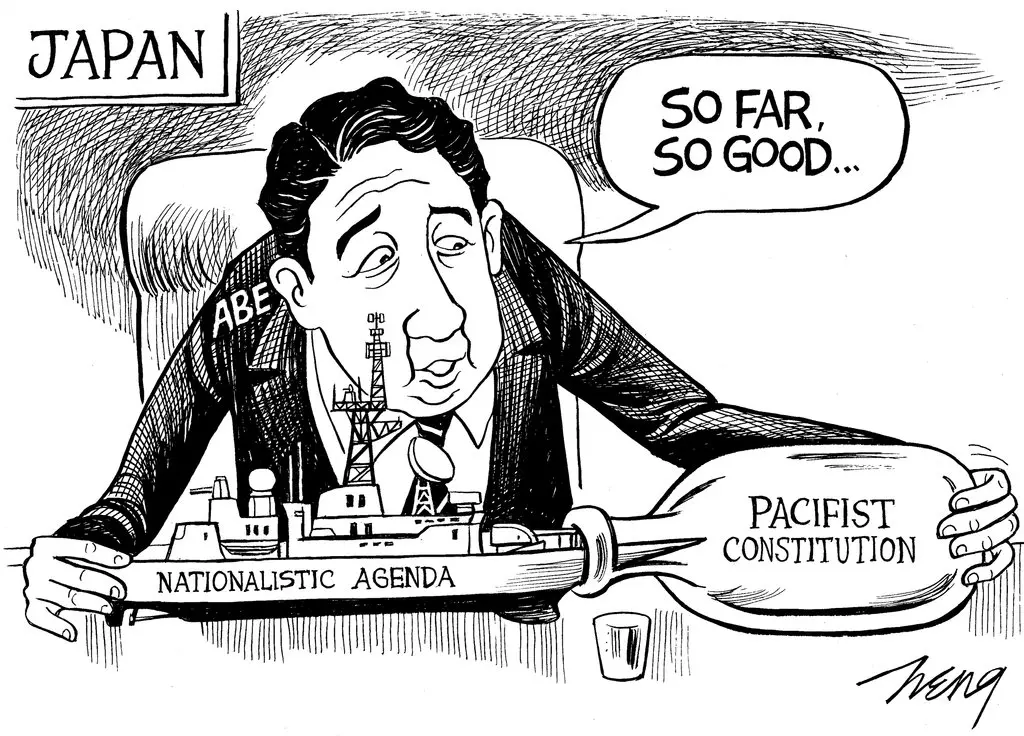This is the first article to be published in our collaboration with IE University’s International Policy Review. Over the next days, you can discover the diverse topics that students in Madrid chose as their submissions to the project.

Image credit: Heng, 2013
By Hugo Mack. Edited by Henri Klein.
World War II remains one of the most cataclysmic and catastrophic conflicts in modern history. The nuclear bombings of Hiroshima and Nagasaki marked its end. These catastrophic weapons significantly altered global politics and decisively affected Japan, transforming its society and economy after experiencing destruction as well as loss in war. After the war, the government adopted a constitutionally enshrined pacifism, emphasizing no more war and the use of military personnel for defense purposes only. The Japanese government supervised by the U.S. did so by employing Article 9 of their constitution, which states, “the Japanese people forever renounce war as a sovereign right of the nation and the threat or use of force as means of settling international disputes.” This decision was primarily due to the destruction and terrors the Japanese endured during the war. Still, it was also due to the influence of the Allied occupation and, more specifically, the U.S. Japan has retained its constitution for all these years and is still one of the oldest unamended constitutions in the world today.
However, with the change in East Asian regional dynamics during the last thirty years, Japan’s security policy has also changed. Japan has re-evaluated its post-World War II pacifist attitude in response to the growing threat from the regional countries, particularly China and North Korea.
North Korea’s role in shaping Japan’s evolution
North Korea is the first significant external national security threat to Japanese sovereignty. The country’s nuclear and ballistic missile tests are widely regarded as erratic and dangerous by a variety of security analysts. In 2022, the nuclear capability of North Korea’s nuclear weapons capability dramatically increased with almost 70 missile experiments, including several intercontinental ballistic missile tests (ICBMs) and six nuclear tests.
Japan’s defensive military stance has been incrementally changing, with 2014 being a defining moment for strategic policy shifts exemplified in the reevaluation of Article 9 of its constitution and the following year with the 2015 implementation of peace and security legislation. Both policy changes lead to increased military alliances and more substantial self-defense capabilities. North Korea’s persistent missile threats over the recent decade have prompted an increasing shift towards a more assertive state in Japan’s foreign policy.
Furthermore, the Japanese archipelago and the US mainland are within North Korea’s technological and operational reach. Following the August 1998 launch of the Taepodong I, Japan acknowledged North Korea as a threat to its national security for the first time. North Korea launched a ballistic missile based on a submarine in May 2022, three days before the inauguration of new South Korean President Yoon Suk Yeol. Japanese Defense Minister Nobuo Kishi responded immediately by significantly improving Japan’s defense capabilities. Former Prime Minister Kishida described the most severe and complicated security environment since World War II due to historical shifts in power balances and growing geopolitical conflict. Japan must strengthen its defence capabilities significantly to prepare for the worst scenarios.
China’s Expanding Influence and the Diaoyu Islands Dispute
China’s growing military power, increasingly imposing diplomacy, and historical and territorial disputes with Japan have placed the Diaoyu Islands at the heart of East Asian security tensions. These uninhabited islands are strategically important for both countries due to the variety of natural resources they provide and their strategic military location. Still, more notably, they hold emblematic significance regarding both countries’ national identity and sovereignty.
In 2012, Japan nationalized three islands from private owners, which was a turning point in the dispute. China then increased its military presence around the newly seized territories, increasing air and naval patrols.
Japan used the 1951 San Francisco Peace Treaty to justify its sovereignty over the islands. China argues that the islands are its national territory due to their history, specifically the Ming dynasty. Both China and Japan want to fend their sovereignty and exercise their influence in the East Asian region, but they are unwilling to come to an agreement.
This conflict represents the fragility of the East Asian region. Because China and Japan are economically dependent on each other, war is unlikely, but negotiations and diplomacy are necessary to resolve disputes and reduce regional tensions.
Japan’s Proactive Strategic Defense Shift
On December 16, 2022, Kishida’s government approved three new strategic documents: the National Defence Strategy (NDS), the National Security Strategy (NSS), and the Defence Build-up program. Both the NSS and the NDS aim to strengthen Japan’s defense capabilities. According to the NDS, Japan must confront the disappointing truth that there is a sense of urgency concerning the global security environment. It must drastically enhance its defence capabilities, emphasizing opponent capabilities and new forms of warfare, to defend the peaceful livelihoods of Japanese nationals. The NSS acknowledges that Russia’s action against Ukraine has easily violated the fundamental base of the principles that shape the international order and that similar acts of aggression cannot be ruled out in East Asia, given the prospect of Chinese coercion. In this environment, Japan is seeking to improve its defense capabilities significantly. Specifically, Japan will enhance the capabilities of all Japanese self-defense troops (SDF), enabling it to respond to hostile forces from beyond the immediate threat zone.
As tensions in the East Asian region intensified, it was felt that Japan’s defence policy needed to change significantly: Japan now considers the choice of preventive counterattacks—which consist in striking an enemy’s launch facilities before they fire their missiles—to be a viable strategy for its national defense. This would mean that Japan could target enemy bases before they have the opportunity to launch a missile, thus preventing any missile from reaching the island. The country justifies this in a government statement issued on February 29, 1956, by former Prime Minister Ichirō Hatoyama, stating that “as long as it is deemed that there are no other means to defend against attack by guided missiles and others, to hit the bases of those guided missiles and others is legally within the purview of self-defense and thus permissible.”
The recent strategic documents approved by Japan show that the potential for preventive counterattacks has changed Japan’s self-defense position. Due to instability and security threats in the East Asian region, Japan has shifted its previous defensive strategy towards a bolder approach, leading it to adopt a more assertive posture.
Japan has seen a shift from its traditional constitutional pacifism to what we call defensive realism. This theory emphasizes that the international system encourages moderate and limited behavior to ensure the security and, more importantly, the survival of the State. Although Japan’s peace remains an essential element of its identity, recent actions have revealed that the capacity to wage war contradictorily is indispensable for living in peace. In the face of growing regional threats, Japan must be able to adjust its peace and power in a delicate balance between maintaining its peaceful ideals and maintaining its sovereignty.
Other posts that may interest you:
Discover more from The Sundial Press
Subscribe to get the latest posts sent to your email.




